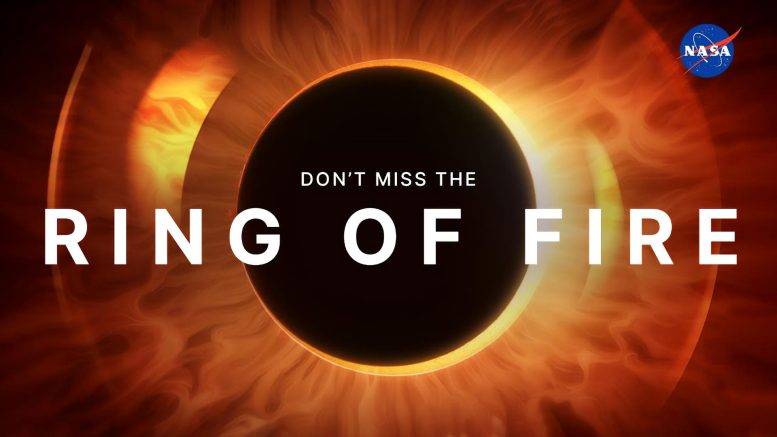
The annular total solar eclipse on October 14, 2023, will span from the U.S. to Brazil. For best views, be in the path of annularity or join NASA’s YouTube at 10:30 a.m. CT for a virtual experience. Credit: NASA
An annular total solar eclipse will be visible across regions from the northwestern U.S. to Brazil on October 14, 2023. This event, characterized by the Moon’s “ring of fire” appearance around the Sun, occurs when the Moon is at its farthest from Earth.
On October 14, 2023, an annular total solar eclipse will be visible to millions across the globe as it sweeps through the skies of the northwestern United States through Mexico and Central America and into South America, exiting the continent in Brazil. Even if you are not in the path of annularity, you will still be able to see a partial solar eclipse if weather conditions are right.
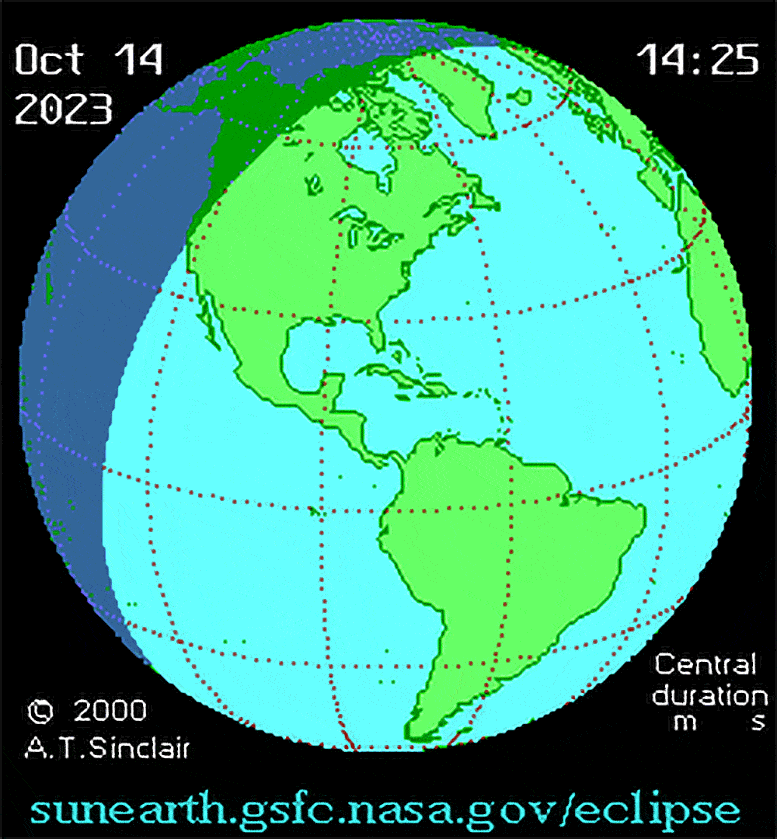
Animated map showing the 2023 annular eclipse path (red dot) and partial eclipse visibility (shadowed area). Credit: Eclipse Predictions by Fred Espenak, NASA’s GSFC
An annular solar eclipse occurs when the Moon comes directly between the Earth and the Sun, but due to its elliptical orbit, the Moon is too far away from the Earth to cover the Sun completely. This is in contrast to a total solar eclipse, where the Moon completely obscures the Sun, resulting in a brief period of daytime darkness.
The term “annular” is derived from the Latin word “annulus,” which means ring-shaped.
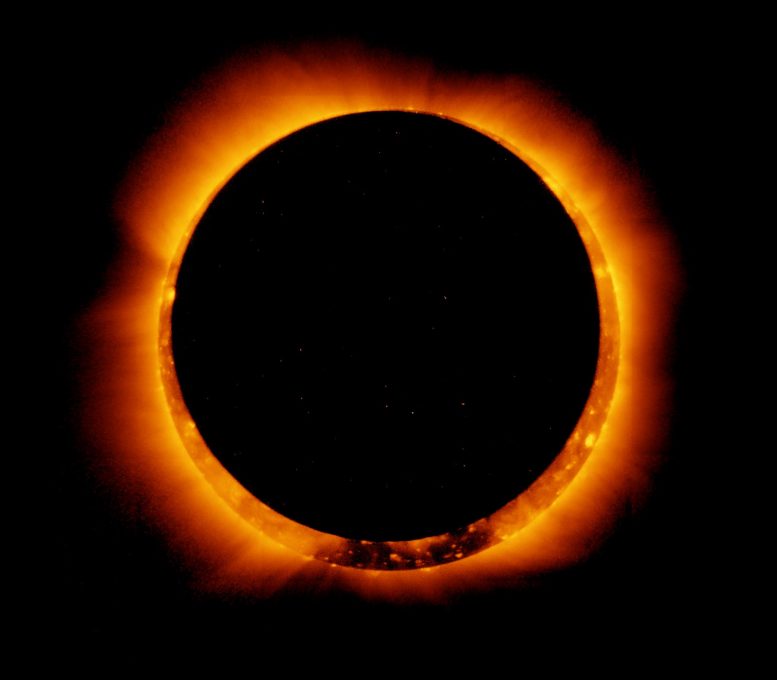
NASA’s Hinode satellite captured this breathtaking image of an annular solar eclipse on January 4, 2011. Credit:
NASA/Hinode/XRT
In an annular solar eclipse, the outer edge of the Sun remains visible as a bright ring surrounding the dark disk of the Moon. This phenomenon occurs because the apparent diameter of the Moon is smaller than that of the Sun. In other words, the Moon does not appear large enough in the sky to cover the Sun entirely.
Ring of Fire
The “ring of fire” is a colloquial term used to describe the appearance of the Sun during an annular solar eclipse. As mentioned, during such an eclipse, the Moon does not cover the Sun completely. The resulting effect is a bright, ring-like outline of the Sun’s circumference. This luminous ring, which is actually the Sun’s outer edge, resembles a ring of fire due to its blazing appearance against the comparatively dark sky. It’s a stunning visual that is eagerly awaited by skywatchers and astronomers alike whenever an annular eclipse is predicted.
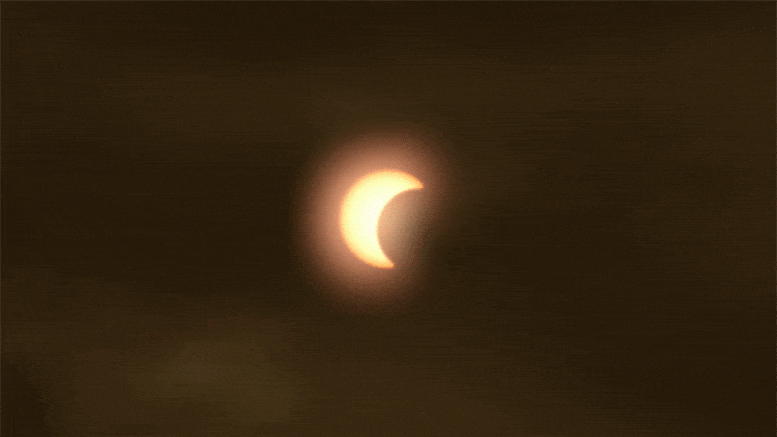
This conceptual animation is an example of what you might expect to see through certified solar-viewing glasses or a handheld solar filter during an annular solar eclipse, like the one happening over the United States on October 14, 2023. Annular eclipses are famous for the “ring of fire” effect that appears around the edge of the Moon. This happens because the Moon is slightly farther from Earth and appears too small to block out the Sun completely. Credit: NASA
It’s essential to note that the “ring of fire” is extremely bright and can cause damage to the eyes if viewed without proper protective eyewear. Observers should always use specially designed solar viewing glasses or other safe viewing methods when watching any phase of a solar eclipse.
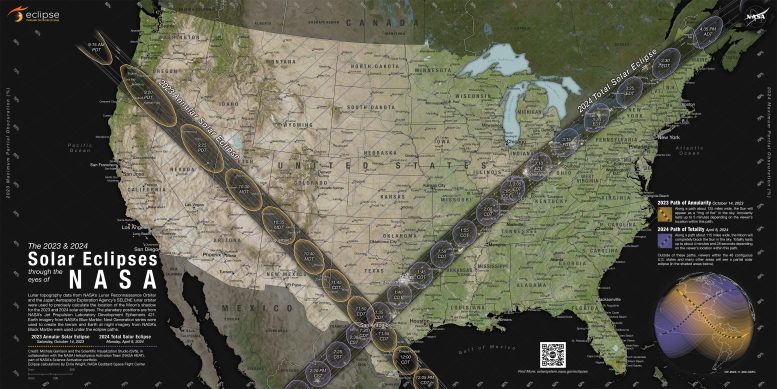
Using observations from different NASA missions, this map shows where the Moon’s shadow will cross the U.S. during the 2023 annular solar eclipse and 2024 total solar eclipse. The map was developed by NASA’s Scientific Visualization Studio (SVS) in collaboration with the NASA Heliophysics Activation Team (NASA HEAT), part of NASA’s Science Activation portfolio. Credit: NASA/Scientific Visualization Studio/Michala Garrison; eclipse calculations by Ernie Wright, NASA Goddard Space Flight Center
A map (above) developed using data from a variety of NASA sources shows a detailed eclipse path and what observers across the States can expect to see at their local time.
During a total solar eclipse, like the upcoming 2024 Solar Eclipse, the Moon is close enough to Earth to be sufficiently large to completely cover the bright face of the Sun. During the few minutes of totality, there will be darkness around midday.
Two solar eclipses will cross the United States in 2023 and 2024. On October 14, 2023, an annular solar eclipse will create a “ring of fire” in the sky from Oregon to Texas. On April 8, 2024, a total solar eclipse will darken the skies from Texas to Maine. On both dates, all 48 contiguous states in the U.S. will experience a partial solar eclipse. A map developed using data from a variety of NASA sources shows both eclipse paths as dark bands. Outside those paths, yellow and purple lines show how much of the Sun will become blocked by the Moon during the partial eclipses. This video zooms in to different parts of the map, explaining these and other features that describe what observers across the country can expect to see during each eclipse.
What you can see during an annular eclipse depends on the weather and your location.
- You need a clear sky to see the eclipse. However, even with cloud cover, the eerie daytime darkness associated with eclipses is still noticeable to human animals as well as the four-footed ones and the flying ones. Birds go to roost, bees return to the hive, and even turtles come out of ponds.
- To see all phases of an annular eclipse, including the “ring of fire,” you must view it from somewhere within the path of annularity.
On October 14, 2023, a “ring of fire,” or annular, solar eclipse will travel from the Oregon coast to the Gulf of Mexico. Weather permitting, most of the Americas will be able to view at least a partial solar eclipse. Credit: NASA
If you are not within the path of annularity, watching the eclipse from a virtual location is a great option. Join NASA for conversations with scientists and telescope views from across the country on NASA’s YouTube beginning at 10:30 a.m. CT on October 14, 2023.









It would such a beautiful sight for sore eyes. Where in Africa is it going to be more spectacular though?. I’m from Zimbabwe